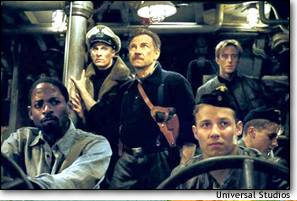U-571
 U-571 from Universal Pictures
U-571 from Universal Pictures
|
This film is a fictional acount of the capture of a German submarine in 1942 by an American crew, but is based on the historical reality of the Battle of the Atlantic and the secret capture of the Enigma cipher machine from German boats. The film was inspired by several real events: the British seizure of U-110 south of Iceland in May 1941 with an Enigma machine and Hydra cipher; the U-559 in the Mediterranean with a short weather Enigma cipher book in Oct. 1942 that allowed the British to break the new German Triton cipher; the capture of the U-505 by U.S. Navy in June 1944. It was also inspired by director Jonathan Mostow's visit to several World War II submarines on exhibit in the U.S., including the USS Pampanito in San Francisco, the U-505 in Chicago. In Malta, Mostow built full-size replicas of a German type VII U-boat and an American S-boat for exterior shots filmed in large water tanks and in the open ocean. Interior scenes were filmed on sound stage #5 at the Cinecitta Studios in Rome, the largest sound stage in Europe. Technical consultant David Kahn, in an interview for the History Channel documentary History or Hollywood? U-571, said the movie is an accurate portrayal of the Battle of Atlantic and importance of Ultra intelligence to Allied victory and the great risks taken to acquire this intelligence and sacrifices of submariners. However, veterans James Healy and former German submariner Herbert Werner (author of Iron Coffins) said the film was more Hollywood than history and did not portray life on World War II submarines accurately. Werner said the depth charges were wrong and the boat would have been destroyed by the force of so many near explosions. In the boats during these attacks, nobody was thrown around, no rivets flying (subs were welded, not riveted). In reality, depth charges would have exploded below the boat and caused cracks that would have been enough to sink the boat very quickly. Also, Healy and Werner agreed that it would have been impossible for an American crew to operate a German sub so quickly, even if some of the crew could read German. Also, subs were not used to attack other subs in World War II. The movie fails to portray how a sub smelled, how everyone shared a single toilet, ate spoiled food, suffered weeks of boredom before sighting a convoy. The young actors in the film quickly lost their Navy haircuts and only the Germans grew beards after weeks at sea without being able to use scarce fresh water for shaving or bathing. Tonya Allen in the uboat.net review is critical of the film for perpetuating the myth of German submarines machine-gunning helpless liferafts. However, the film accurately portrays the poor condition in 1942 of American S-class subs that dated from World War I, the service on Navy ships of African-Americans.
References:
- Gannon, Michael. Operation Drumbeat : the dramatic true story of Germany's first U-boat attacks along the American coast in World War II. New York: Harper & Row, 1990. 490 p.
- Hickam, Homer H. Torpedo Junction: U-Boat war off America's East coast, 1942. Annapolis, Md.: Naval Institute Press, 1989, 1996 paperback. 367 p.
- "History is back in action," USA Today, April 21, 2000
- Kahn, David. The Codebreakers: the story of secret writing. New York: Macmillan, 1967, revised edition 1996 by Scribner. 1164 p. CL Book Stacks 001.51 K12c
- Kahn, David. Seizing the Enigma: the race to break the German U-boat codes, 1939-1943. Boston : Houghton Mifflin Co., 1991. 336 p.
Werner, Herbert A. Iron Coffins; a personal account of the German U-boat battles of World War II. New York: Holt, Rinehart and Winston, 1969. 329 p.
This review was posted to
the University of San Diego website in January 2002 and is copyright
Steve Schoenherr. It was taken down in 2010, whereupon I copied it to this
website.
